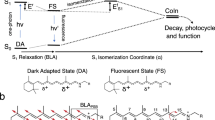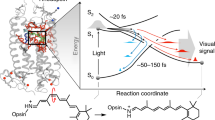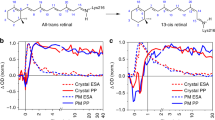Abstract
BECAUSE 11-cis retinal is the chromophore of the visual pigment in vertebrate rods, and its isomerization to the all-trans form (Ia) is known to occur during visual excitation1–4, the properties of the retinal isomers are of considerable interest. Although it has long been assumed that non-bonded repulsions in 11-cis retinal distort the polyene chain, the details of the ground state geometry have not been determined, nor has the experimental spectrum been correlated unequivocally with the excited states. In this communication, we present a theoretical ground state potential function with a form which may help to explain some of the unusual spectral characteristics of the retinal isomers when in solution or incorporated into the native visual pigment1–4.
This is a preview of subscription content, access via your institution
Access options
Subscribe to this journal
Receive 51 print issues and online access
$199.00 per year
only $3.90 per issue
Buy this article
- Purchase on Springer Link
- Instant access to full article PDF
Prices may be subject to local taxes which are calculated during checkout
Similar content being viewed by others
References
Wald, G., Science, 162, 230 (1968).
Hubbard, R., Bounds, D., and Yoshizawa, T., Cold Spring Harbor Symp. Quant. Biol., 30, 301 (1965).
Abrahamson, E. W., and Ostroy, S. E., Prog. Biophys. Mol. Biol., 17, 179 (1967).
Hubbard, R., and Wald, G., in Structural Chemistry and Molecular Biology (edit. by Rich, A. and Davidson, N.) (Freeman, San Francisco, 1968).
Williams, D. W., J. Chem. Phys., 45, 3770 (1966).
Nash, H., J. Theoret. Biol., 22, 314 (1969).
Sheraga, H. A., Adv. Phys. Org. Chem., 6, 103 (1968).
Williams, J. E., Stang, P. J., and von R. Schleyer, P., Ann. Rev. Phys. Chem., 19, 531 (1968).
Allinger, N. L., Hirsch, J. A., Miller, M. A., and Tymanski, I. J., J. Amer. Chem. Soc., 91, 1199 (1968).
Allinger, N. L., Hirsch, J. A., Miller, M. A., and Tymanski, I. J., J. Amer. Chem. Soc., 91, 5773 (1968).
Wiesenfeld, J. R., and Abrahamson, E. W., Photochem. Photobiol., 8, 487 (1968).
Imuzaka, K., and Becker, R. S., Nature, 219, 389 (1968).
Patel, D., Nature, 221, 826 (1969).
Sperling, W., and Rafferty, C., Nature, 224, 591 (1969).
Jutkowitz, L., Nature, 184, 614 (1959).
Loeb, J. N., Brown, P. K., and Wald, G., Nature, 184, 617 (1959).
Oroshnik, W., and Mebane, A. D., J. Amer. Chem. Soc., 76, 5719 (1954).
Dorfman, L., Chem. Rev., 53, 47 (1953).
Allinger, N., and Miller, M. A., J. Amer. Chem. Soc., 86, 2811 (1964).
Oroshnik, W., Brown, P., Hubbard, R., and Wald, G., Proc. US Nat. Acad. Sci., 42, 578 (1956).
Grellmann, K. H., Livingston, R., and Pratt, D., Nature, 193, 1258 (1962).
Grellmann, K. H., Livingston, R., and Pratt, D., Photochem. Photobiol., 3, 121 (1967).
Author information
Authors and Affiliations
Rights and permissions
About this article
Cite this article
HONIG, B., KARPLUS, M. Implications of Torsional Potential of Retinal Isomers for Visual Excitation. Nature 229, 558–560 (1971). https://doi.org/10.1038/229558a0
Received:
Revised:
Issue Date:
DOI: https://doi.org/10.1038/229558a0
This article is cited by
-
A multiscale ONIOM study of the buckminsterfullerene (C60) Diels–Alder reaction: from model design to reaction path analysis
Journal of Molecular Modeling (2022)
-
Conformational investigation on retinal by PCILO method
Proceedings / Indian Academy of Sciences (1981)
-
Linear dichroism of rhodopsin in air-water interface films
The Journal of Membrane Biology (1979)
-
Bicycle-pedal model for the first step in the vision process
Nature (1976)
Comments
By submitting a comment you agree to abide by our Terms and Community Guidelines. If you find something abusive or that does not comply with our terms or guidelines please flag it as inappropriate.



